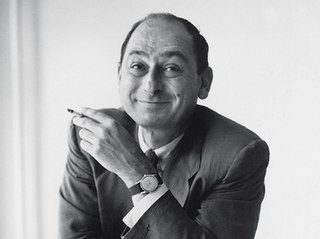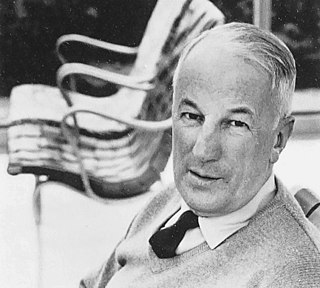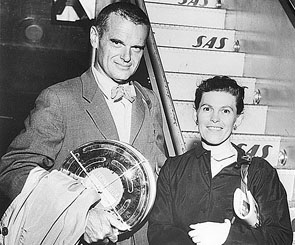Related Research Articles

Eero Saarinen was a Finnish-American architect and industrial designer who created a wide array of innovative designs for buildings and monuments, including General Motors Technical Center in Warren, Michigan; the passenger terminal at Dulles International Airport outside Washington, D.C.; the TWA Flight Center at John F. Kennedy International Airport; and the Gateway Arch in St. Louis. He was the son of Finnish architect Eliel Saarinen.

The Eames House is a landmark of mid-20th century modern architecture located at 203 North Chautauqua Boulevard in the Pacific Palisades neighborhood of Los Angeles. It was constructed in 1949, by husband-and-wife design pioneers Charles and Ray Eames, to serve as their home and studio. The house was commissioned by Arts & Architecture magazine as part of its Case Study House program, challenging architects to design progressive, but modest, homes in Southern California. Charles and Ray moved into the home on Christmas Eve in 1949 and never moved out. Charles's daughter, Lucia Eames, inherited the home and created the non-profit organization, the Eames Foundation, in 2004. Still a historic house museum maintained by the Eames Foundation, it was designated a National Historic Landmark in 2006 and serves as a pilgrimage site for nearly 20,000 visitors a year.

George Nelson was an American industrial designer. While lead designer for the Herman Miller furniture company, Nelson and his design studio, George Nelson Associates, designed 20th-century modernist furniture. He is considered a founder of American modernist design.
MillerKnoll, Inc., doing business as Herman Miller, is an American company that produces office furniture, equipment, and home furnishings. Its best known designs include the Aeron chair, Noguchi table, Marshmallow sofa, Mirra chair, and the Eames Lounge Chair. Herman Miller is also credited with the 1968 invention of the office cubicle under then-director of research Robert Propst.

Bruno Mathsson was a Swedish furniture designer and architect whose ideas aligned with functionalism, modernism, as well as old Swedish crafts tradition.

Cardboard furniture is classified as furniture designed and made from corrugated fibreboard, heavy paperboard, honeycomb board, fibre tubes or a combination of these materials. Cardboard furniture is misleading, since "cardboard" is a depreciated term, describing mainly corrugated cardboard, but not being sufficiently specific to describe the various forms of paper-based boards used today in order to make furniture.

Vitra is a Swiss family-owned furniture company with headquarters in Birsfelden, Switzerland. It is the manufacturer of the works of many furniture designers. Vitra is also known for the works of notable architects that make up its premises in Weil am Rhein, Germany, in particular the Vitra Design Museum.

Alexander Girard, affectionately known as Sandro, was an architect, interior designer, furniture designer, industrial designer, and a textile designer.
Francis D. K. "Frank" Ching is an architecture and design graphics writer. He is Professor Emeritus at the University of Washington.

Charles Ormond Eames Jr. was an American designer, architect and filmmaker. In professional partnership with his spouse Ray Kaiser Eames, he was responsible for groundbreaking contributions in the field of architecture, furniture design, industrial design, manufacturing and the photographic arts.

Bernice Alexandra Kaiser Eames was an American artist and designer who worked in a variety of media.

Charles Eames and Ray Eames were an American married couple of industrial designers who made significant historical contributions to the development of modern architecture and furniture through the work of the Eames Office. They also worked in the fields of industrial and graphic design, fine art, and film. Charles was the public face of the Eames Office, but Ray and Charles worked together as creative partners and employed a diverse creative staff. Among their most recognized designs is the Eames Lounge Chair and the Eames Dining Chair.
Henry P. Glass was an Austrian-born American designer, architect, author, and inventor.

Jack Lenor Larsen was an American textile designer, author, collector and promoter of traditional and contemporary craftsmanship. Through his career he was noted for bringing fabric patterns and textiles to go with modernist architecture and furnishings. Some of his works are part of permanent collections at prominent museums including Museum of Modern Art, Victoria and Albert Museum, Art Institute of Chicago,Musée des Arts Décoratifs at the Louvre, and the Minneapolis Institute of Art which has his most significant archive.

Ramot Polin is a part of the Israeli settlement of Ramot, in northwest East Jerusalem. It was constructed by the Kollel Polen (Poland) in stages beginning in 1972, under the auspices of the Office for Building and Habitation, and is populated, as intended, mostly by Haredi Jewish families, including Breslov. The neighborhood contains 720 housing units of varying sizes.
Los Angeles Modern Auctions (LAMA) is the first auction house to specialize in 20th century Modern art and design. Founded by Peter Loughrey in 1992, LAMA especially champions Modern and Contemporary works by California and West Coast artists and designers.

Eames: The Architect and the Painter is a 2011 documentary film about American designers Charles and Ray Eames and the Eames Office. It was produced and written by Jason Cohn, and co-produced by Bill Jersey.
Don Charles Albinson was an American industrial designer who made many contributions to the world of furniture. He worked with Charles and Ray Eames for 13 years, helping develop many of the seminal Herman Miller furniture pieces from the mid century – the bent plywood chair, the fiberglass shell chair, the aluminum group set, and the Eames Lounge chair, to name a few. He later developed the Knoll Stack chair, the Westinghouse office line, an update to the DoMore Series 7 landscape system named Neo 7, the Albi stack chair for Fixtures, and the Bounce chair for Stylex.

The curved space diamond structure is a patented modular building system representative of a diamond crystal enlarged 8 billion times. These playground climbing sculptures were installed in dozens of parks and playgrounds in California, and also throughout the U.S. and Japan in the mid 1970s and early 1980s. Initially installed as playground climbing sculptures, they have also been exhibited as architectural design pieces, referred to as "usable artworks", and sold as art at auction.

The Eames Molded Plastic & Fiberglass Armchair is a fiberglass chair, designed by Charles and Ray Eames, that appeared on the market in 1950. The chair was intentionally designed for the International Competition for Low-Cost Furniture Design. This competition, sponsored by the Museum of Modern Art, was motivated by the urgent need in the post-war period for low-cost housing and furnishing designs adaptable to small housing units.
References
- 1 2 Neuhart, Marilyn Neuhart, with John (2010). The story of Eames Furniture. Berlin: Gestalten. pp. 200–207. ISBN 9783899552300.
{{cite book}}: CS1 maint: multiple names: authors list (link) - ↑ "Peter Jon Pearce".
- ↑ Amber Dohrenwend. "Peter Pearce's "Curved Space Diamond Structure"".
- ↑ Eames, John Neuhart, Marilyn Neuhart, Ray (1989). Eames design : the work of the Office of Charles and Ray Eames (3. printing ed.). New York: H.N. Abrams. pp. 227, 241, 249, 253, 265, 275, 283. ISBN 9780810908796.
{{cite book}}: CS1 maint: multiple names: authors list (link) - ↑ Shiela Gibson Stoodley (September 2008). "Objects of Desire: Molecular Level". Art & Antiques Magazine: 30–31.
- ↑ John Allen, FLS. "Buckminster Fuller's Synergetic Algorithm and Challenges of the Twenty-First Century".
- ↑ Pearce, Peter (1990). Structure in nature is a strategy for design (5th print. ed.). Cambridge u.a.: MIT Press. ISBN 0262660458.
- ↑ Cullen, Cheryl Dangel; Haller, Lynn (2004). Design secrets. 50 real-life projects uncovered : projects chosen by the Industrial Design Society of America. Gloucester, MA: Rockport Publishers. ISBN 978-1592530717.
- ↑ Roberta Cruger. "Dwell on Design Conference: Dispatch from Day One".
- ↑ "Peter J. Pearce Patents".
- ↑ "Getty's Pacific Standard Time Series on L.A. Architecture: A Preview". Archived from the original on December 11, 2013. Retrieved December 3, 2013.
- ↑ Katya Tylevich. "Everything Loose Will Land".